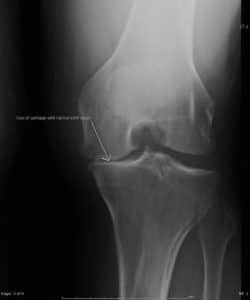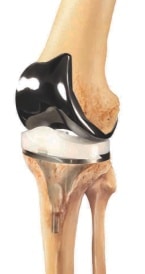Knee osteoarthritis is very common. When the pain from your knee arthritis becomes severe, and your quality of life is poor, one of your options will be to consider knee replacement surgery.
Many non-surgical treatments are tried first. These may also include a promising new non-surgical procedure we call an embolization. If non surgical treatments fail, you may find your self considering a knee replacement. This is a big step. Many of you have friends who did very well after their knee replacement, yet some of your friends might not have done well. You have many questions about knee replacement surgery. Hopefully this video discussion about knee replacement surgery, or the transcript of the video below helps to address many of those questions.
Your physician has recommended a knee replacement and you are curious about your options. You have a million questions and you are very nervous. Facing major reconstructive surgery can be very daunting.
Hopefully, this video will assist you in answering some of those lingering questions regarding knee replacements. Hopefully, I will improve your level of understanding about knee replacements … and most importantly, hopefully, you will learn about your options available to people facing a possible knee replacement procedure.
A knee replacement is performed for severe osteoarthritis. Usually, an X-ray is all that is necessary to determine if severe arthritis is present. MRI’s are rarely necessary. More important than the fact that your Xray reveals severe arthritis is the fact that it must be symptomatic. That means your knee pain must be severe. There are plenty of people walking around with rather severe arthritis and do not even know it. You may have been told to have a knee replacement but your pain does not significantly impact upon their quality of life. They clearly do NOT require a knee replacement. For the vast majority of you, the decision to proceed with a knee replacement should be based on the effect that the arthritis is having on your quality of life. You should be the one asking for a knee replacement, rarely should a surgeon convince you to have one.
Should I Have A Knee Replacement?

This is a question that only you can answer. You may have severe osteoarthritis on X-ray—and you may have pain; but perhaps the pain is not particularly limiting or bothersome, and pills, rubs, balms, or whatever help you maintain an active lifestyle. Well, my friend, you may not need your knee replacement— yet. A surgeon should not tell you that you NEED a knee replacement. It is merely one of the options available. Because it is an elective operation, the decision to go ahead with surgery should be a “shared decision-making process.” The folks at WebMD have put together a program to help you think through the decision-making process to see whether or not a knee replacement is a right option for you at this particular time. The government has come out with a long, but thorough presentation about knee replacements. If you are seriously considering surgery, it is well worth your time and effort to check out.
Some of the more recent treatment options (circa 2018) are seeing very encouraging results. I speak specifically about an embolization procedure for knee osteoarthritis. You can read about that here.
I Have Decided To Have A Knee Replacement, What Are My Options?
Knee replacement technology and knowledge continue to advance. Some are true breakthroughs and represent a big leap forward. What has improve most of all is the management of pain. Patients are usually in far less pain after a knee replacement surgery than patients were just 5-10 years ago. Injections inside the knee, nerve blocks and various non-narcotic medications have made this a far more tolerable procedure for most. Yes, you still have pain after a knee replacement, it is simply more controllable and more tolerable that it was previously.
Knee Prosthetic design
Prosthetic design has some a long way over the last few years. Although they are still far from producing a knee replacement that behaves like the “normal” knee you had as a healthy 20-something. Knee prosthetics produced today more accurately recreate the anatomy and function of your normal knee. Older designs acted simply as a hinge. Today the prosthetics are designed to behave a bit more like the knee you used to have. We still have a ways to go to get to the perfect knee replacement, but today’s options are better than those that were available 10 years ago.
There is a lot of discussion and controversy over gender-specific knee replacements. Most all newer knee replacement systems available are gender-sensitive and offer the surgeon numerous sizing options so the knee prosthesis we choose at the time of surgery fits your knee appropriately.
Total knee replacement or partial knee replacement
A knee has three compartments. If arthritis affects only one or two of the compartments, different replacement options become available. Aside from the choice of the appropriate prosthesis to use, surgeons also have the option of replacing only a single compartment of the knee (unicompartmental arthroplasty). The benefit of a partial knee replacement is that your ligaments will not need to be removed like they are in most full knee replacements. Theoretically, your knee will function on a more “normal” level after a partial knee replacement. A partial knee replacement usually feels more like your normal knee.
Surgical approach for knee replacement
Surgical approaches or incisions haven’t changed significantly over the past 5-7 years. Most patients can have their knee put in through a muscle-sparing (no cutting of muscle) “sub-vastus” approach. Patients who have this form of knee exposure often experience a more rapid return of function in the early post-operative period. There is typically less atrophy and less weakness associated with this approach as well. Perhaps more important, if future surgery were necessary, this preserves the quadriceps tendon. The fewer times that tendon is cut, the better your function will be.
Computer Assisted surgery
Computer Assisted surgery has become very popular lately. We utilize the Stryker Computer Navigation System. Utilizing the computer navigation system allows us to place the prosthesis in your knee more precisely than we could be using older “freehand” techniques. It takes just a few more minutes and can make a great surgeon even better — and perhaps more accurate!
What Are The Risks of a Knee Replacement?
The reasonably foreseeable risks of a knee replacement include, but are not limited to infection, stiffness, patella instability, persistent pain, nerve or blood vessel injuries, a feeling like the replacement is loose or unstable, blood clots in the legs, pulmonary emboli (blood clots that travel to the lungs), the need for revision surgery if the prosthesis loosens or becomes infected, and perhaps even Chronic Regional Pain Syndrome. You are treated with antibiotics to minimize the risk of infection. You are treated with medications and compression boots to minimize risk of blood clots, and you work with a physical therapist to minimize risks of stiffness. Despite our efforts, complications can and do occur. You should review these at length with your surgeon.









